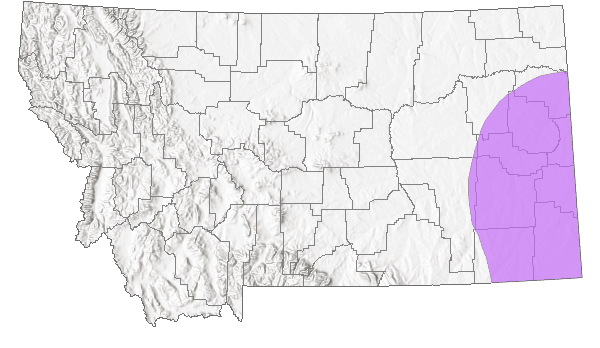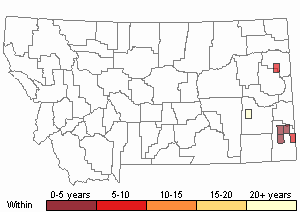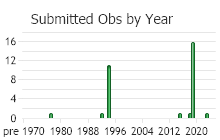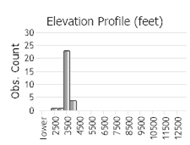View in other NatureServe Network Field Guides
NatureServe
Montana
Utah
Wyoming
Idaho
Wisconsin
British Columbia
South Carolina
Yukon
California
New York
Wilcox's Panic Grass - Dichanthelium wilcoxianum
Other Names:
Dichanthelium oligosanthes var. wilcoxianum, Panicum wilcoxianum
Native Species
Global Rank:
G5
State Rank:
S4
(see State Rank Reason below)
C-value:
Agency Status
USFWS:
USFS:
BLM:
External Links
State Rank Reason (see State Rank above)
Dichanthelium wilcoxianum occurs in Montana on the western edge of its range. A status review of Dichanthelium wilcoxianum within Montana was conducted in 1995 and 2019. It grows best in sandy soils within open grasslands. Plants tolerate some shade, although, conversion of grasslands into dense Ponderosa Pine stands is likely a threat to its long-term survival. Plants seems to respond positively to fire. Plants appear common and populations appear stable; however, herbarium and observation data are almost entirely from U.S. Forest Service managed lands. Current information on lands managed by other agencies in Montana is needed.
- Details on Status Ranking and Review
Range Extent
ScoreE - 5,000-20,000 sq km (~2,000-8,000 sq mi)
Comment14,184 square kilometes
Area of Occupancy
ScoreD - 6-25 4-km2 grid cells
CommentPlant occurs in 8 of the 30,590 4x4 square-kilometer grid cells that cover Montana.
Number of Populations
ScoreB - 6 - 20
Comment14 observations represent 12 distinct occurrences
Number of Occurrences or Percent Area with Good Viability / Ecological Integrity
ScoreC - Few (4-12) occurrences with excellent or good viability or ecological integrity
Threats
ScoreD - Low
CommentGrasses seems to tolerate some disturbance and can grow well after a fire (if not too severe). Grasses can tolerate some shade, but may decline with enough tree encroachment.
General Description
PLANTS: Cool season, bunched, perennial grass growing from a caudex, 10-20 cm tall. Plants spread into undiscernible, clumped rosettes. The inflorescence seldom rising significantly above the upper cauline leaves.
LEAVES: Stems with 2-4, alternately arranged leaves of which the upper two are more widely spaced than the lower two leaves. Blades are 2-5 mm wide, distinctly hairy on both surfaces. Ligule to 1 mm tall. In the fall stems often have shoots arising from mid-stem or lower.
INFLORESCENCE: A diffuse, open panicle, 2–5 cm long, and scarcely exceeding the upper cauline leaves. Branches are short with moderately long pedicels. Spikelets 2.4–3.2 mm long with 1 fertile floret. Glumes conspicuously hairy. First glume 1–1.2 mm long and second glume 2.5–3 mm long. Lemmas blunt and spherical.
Sources: Lesica et al. 2012; Freckman & Lelong in FNA 2007.
Phenology
Mostly in early fruit by mid-June. By early July, some fruit dispersal will have occurred, and pubescence on some glumes will have diminished. Late fruit production observed in late August.
Diagnostic Characteristics
Dichanthelium has been segregated from
Panicum. Montana has 3 species of
Dichanthelium. Members of
Dichanthelium:
* Develop a rosette of short, broad basal leaves during the cool season, while
Panicum species do not.
* Grow during the cool and warm seasons, whereas,
Panicum species grow in the warm season.
* Produce cleistogamous (self-pollinating) florets, which are often found on small axillary inflorescences during the late summer to fall.
Wilcox’s Panic Grass –
Dichanthelium wilcoxianum, native
* Stems 10-20 cm tall.
* Spikelets less than 2.5 mm long.
* Upper and lower leaf surfaces hairy.
* Ligules 1.0 mm or less tall.
* Grasslands and open Ponderosa Pine forests in eastern Montana.
Scribner’s Panic Grass –
Dichanthelium oligosanthes var.
scribnerianum, native, SOC
* Stems 20-50 cm tall.
* Spikelets 2-5 mm long.
* Upper leaf surface is glabrous. Lower leaf surface is hairy.
* Ligules 1-3 mm tall.
* Disturbed sites and open understory in northwest and southeast Montana.
Panic Grass –
Dichanthelium acuminatum subsp.
sericeum, native, SOC
* Stems 10-30 cm tall.
* Spikelets 1.5-2.5 mm long.
* At maturity the larger second glume is often purplish.
* Upper and lower leaf surfaces hairy.
* Ligules 2-6 tall.
*
Often in wet soils around hot springs.
Switchgrass (
Pancium virgatum) is a rhizomatous, perennial grass while Montana's other
Panicum species are annuals.
Species Range
Montana Range
Range Descriptions

 Native
Native
Range Comments
Carter and Custer Counties in Montana. Throughout most central states and provinces in North America (Lesica et al. 2012). Wilcox’s Panic Grass is likely a grass of Great Plains origin (Lesica et al. 2012).
Observations in Montana Natural Heritage Program Database
Number of Observations: 33
(Click on the following maps and charts to see full sized version)
Map Help and Descriptions
Relative Density

Recency



 (Observations spanning multiple months or years are excluded from time charts)
(Observations spanning multiple months or years are excluded from time charts)
Habitat
In Montana Wilcox’s Panic Grass is found in sandy soils within open grassland areas, understories of open Ponderosa Pine stands, in sandy blow-outs, and in gravelly soils (MTNHP Botany Observation Database).
Ecology
HABITAT DISTURBANCE
Plants are common in undisturbed grasslands, but have also been found in areas with two-track roads or where past evidence of moderate to heavy livestock grazing had occurred (MTNHP Botany Observation Database; Hansen, personal communication).
Plants have been found in burned openings within Ponderosa Pine stands (MTNHP botany database). In 2019 Wilcox’s Panic Grass was one of the few species found across areas with high burn severity resulting from a 2012 fire near Ekalaka, Montana (Hansen, personal communication). In some areas plant recovery was not very fast, partly due to burn severity and partly due to very dry sandy soils. Despite these conditions, Wilcox’s Panic Grass was found and appears to respond well to fire.
Plants can be common in the understory of open Ponderosa Pine stands, indicating some tolerance for shade; however, the threshold for shade is unknown (Hansen, personal communication). Plants have not been found in grassland areas converted to thick Ponderosa Pine forest.
Reproductive Characteristics
This grass can produce panicles in both the late spring to early summer and the mid-summer to fall periods (Lesica et al. 2012). Early flowering plants may exhibit both self-pollinating and cross-pollinating florets. Late flowering plants may have panicle branches clustered among the leaves and are composed of self-pollinating florets.
Stewardship Responsibility
Threats or Limiting Factors
Possible long-term threat to Wilcox's Panic Grass may come from conversion of grasslands to dense Ponderosa Pine forests.
References
- Literature Cited AboveLegend:
 View Online Publication
View Online Publication Flora of North America Editorial Committee. 2003. Flora of North America North of Mexico. Vol. 25. Magnoliophyta: Commelinidae (in part): Poaceae, part 2. Oxford Univ. Press, New York. xxv + 781 pp.
Flora of North America Editorial Committee. 2003. Flora of North America North of Mexico. Vol. 25. Magnoliophyta: Commelinidae (in part): Poaceae, part 2. Oxford Univ. Press, New York. xxv + 781 pp. Hansen, Kurt. 2019. Dichanthelium wilxocianum survey information. District Ranger, Custer Gallatin National Forest, Sioux Ranger District, U.S. Forest Service. Personal communication to Andrea Pipp, Program Botanist, MTNHP, Helena, Montana.
Hansen, Kurt. 2019. Dichanthelium wilxocianum survey information. District Ranger, Custer Gallatin National Forest, Sioux Ranger District, U.S. Forest Service. Personal communication to Andrea Pipp, Program Botanist, MTNHP, Helena, Montana. Lesica, P., M.T. Lavin, and P.F. Stickney. 2012. Manual of Montana Vascular Plants. Fort Worth, TX: BRIT Press. viii + 771 p.
Lesica, P., M.T. Lavin, and P.F. Stickney. 2012. Manual of Montana Vascular Plants. Fort Worth, TX: BRIT Press. viii + 771 p.
- Additional ReferencesLegend:
 View Online Publication
View Online Publication
Do you know of a citation we're missing? Heidel, B. L. 1996. Noteworthy collections - Montana. Madrono 43(3):436-440.
Heidel, B. L. 1996. Noteworthy collections - Montana. Madrono 43(3):436-440. Heidel, B.L. and K.H. Dueholm. 1995. Sensitive plant survey in the Sioux District, Custer National Forest, 1994, Carter County, Montana and Harding County, South Dakota. Unpublished report to the Custer National Forest. Montana Natural Heritage Program, Helena, Montana. 95 pp. plus appendices.
Heidel, B.L. and K.H. Dueholm. 1995. Sensitive plant survey in the Sioux District, Custer National Forest, 1994, Carter County, Montana and Harding County, South Dakota. Unpublished report to the Custer National Forest. Montana Natural Heritage Program, Helena, Montana. 95 pp. plus appendices. Lesica, P., M.T. Lavin, and P.F. Stickney. 2022. Manual of Montana Vascular Plants, Second Edition. Fort Worth, TX: BRIT Press. viii + 779 p.
Lesica, P., M.T. Lavin, and P.F. Stickney. 2022. Manual of Montana Vascular Plants, Second Edition. Fort Worth, TX: BRIT Press. viii + 779 p. McGregor, R.L. (coordinator), T.M. Barkley, R.E. Brooks, and E.K. Schofield (eds). 1986. Flora of the Great Plains: Great Plains Flora Association. Lawrence, KS: Univ. Press Kansas. 1392 pp.
McGregor, R.L. (coordinator), T.M. Barkley, R.E. Brooks, and E.K. Schofield (eds). 1986. Flora of the Great Plains: Great Plains Flora Association. Lawrence, KS: Univ. Press Kansas. 1392 pp.
- Web Search Engines for Articles on "Wilcox's Panic Grass"





